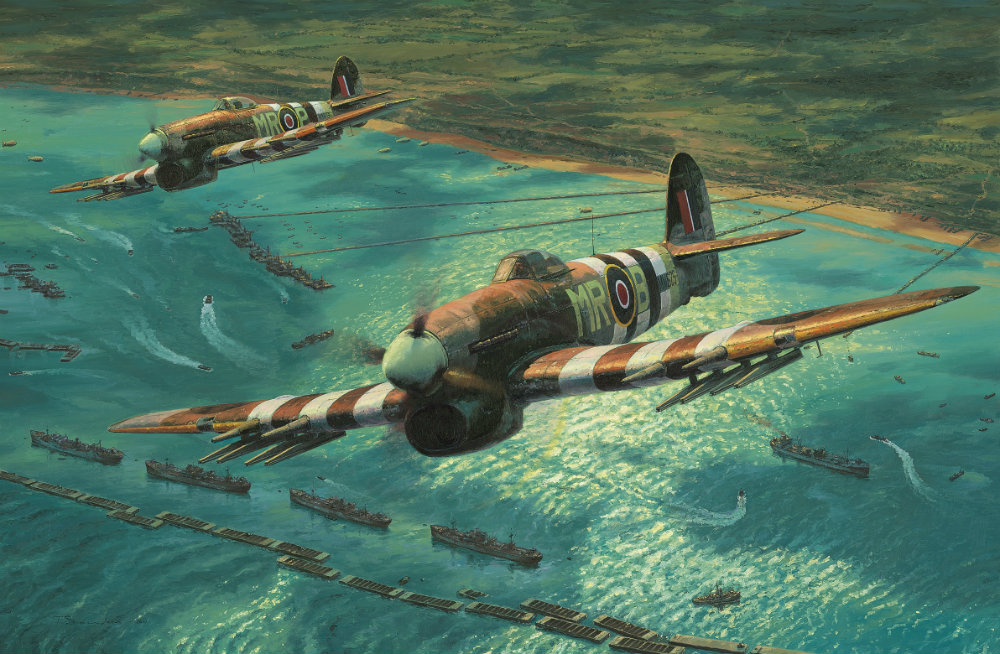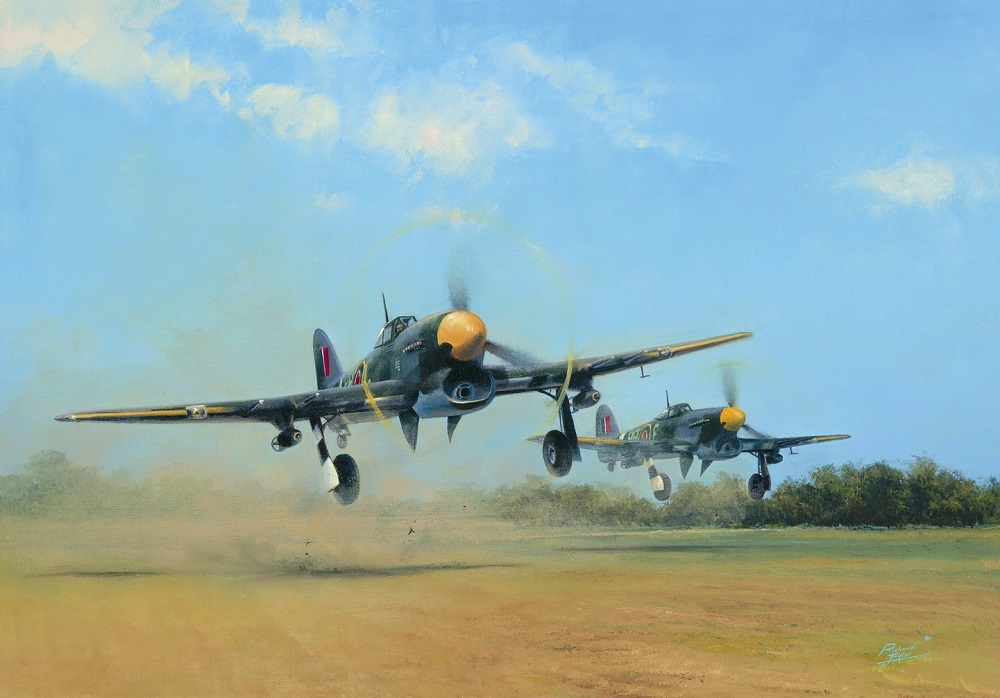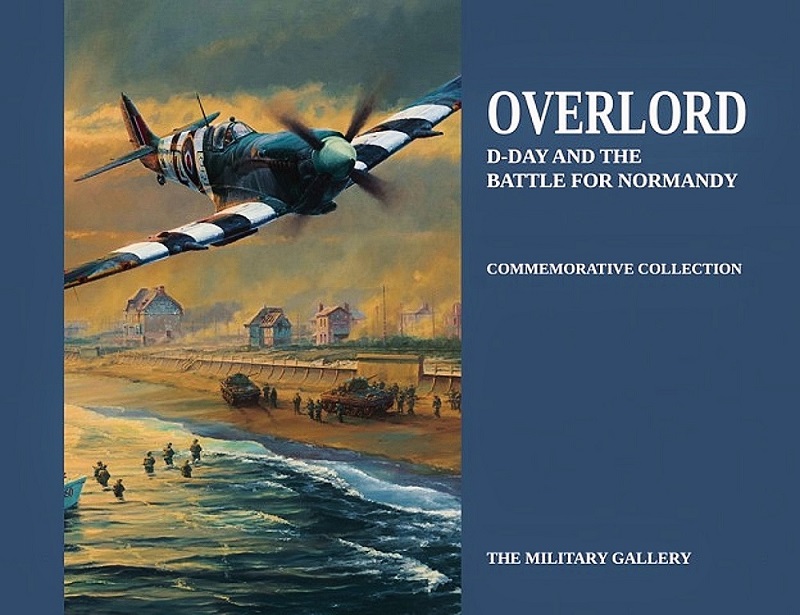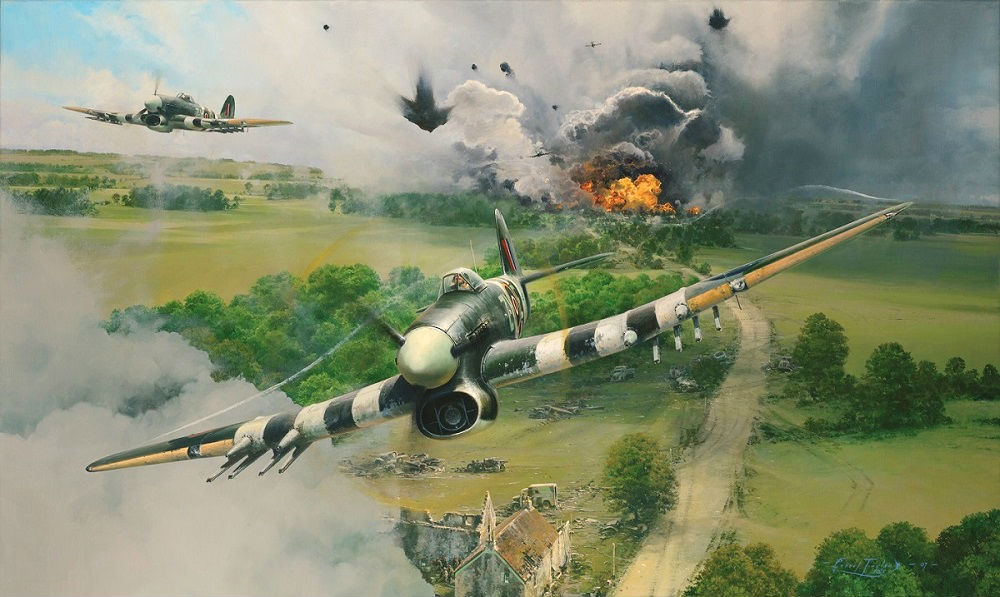On this 76th Anniversary of the ‘Day of Days’, June 6th 1944, while our minds are cast back to the men landing on the beaches of Normandy and the men who flew in support of the troops fighting their way inland, our minds also cast forward four years to the 80th Anniversary of D-Day.
As the 5th East Yorkshires and 6th Green Howards landed on Gold Beach at 07:25, above them the first Hawker Typhoons, now featuring their hastily painted identification stripes, that arrived to offer support were the ‘Bombphoons’ of 143 Wing RCAF. As they approached the coast, they radioed in the headquarters ships to ask if any targets had been called in by the troops just assaulting the beaches. These targets were strong points just behind the beaches being assaulted by the British and Canadians. 438 ‘Wildcat’ Squadron attacked blockhouses overlooking Gold Beach. The low cloud and smoke from the naval bombardment meant that they dived through the cloud and released their 1000lb bombs at only 2000’.

Targets destroyed, the Typhoons raced home to England to refuel and rearm, witnessing the landing craft hitting the beaches below them. The other Typhoons of 2nd Tactical Air Force had been at readiness since dawn, with nine of the eighteen Typhoon squadrons being designated as ‘Air Alert’. This meant that three squadrons at a time could be called upon. The other squadrons had an extensive target list. Gun sites inland from the beaches, as well as the radar sites that they had visited before, were tasked to the squadron who were in action from late morning.
Twelve Typhoons of 198 Squadron departed Thorney Island at 08:25 under the command of Wing Commander Peter Brooker in MN570, famously captured by Pathe. Their target was a Wehrmacht HQ located in the Chateau la Meauffe near St Lo. Crossing the beaches, they had to drop below 2000’ and quickly identified the target and attacked with rockets. They left the building on fire, with smoke billowing from the ground floors. As they headed back north they could see the intense fighting just off the beaches and one 198 Squadron pilot commented that there were “more ships than sea” in the channel.

Around midday six 183 Squadron aircraft were attacking a column of tanks moving up from the south of Caen. As they were about to attack, they were bounced by the Fw190s of I. and III./JG2 under the command of Hptm Herbert Huppertz. Outnumbered, the Typhoons scattered, but the three Typhoons of Welshman Flight Lieutenant Rhys Evans and Canadians Flying Officer Adrian Taylor and Flying Officer Melsom Gee were shot down with the loss of their crews. The myth of no Luftwaffe aircraft over Normandy is put painfully to rest. 183 Squadron would be back again later that afternoon. Huppertz would be killed two days later.
As the number of targets in the beachhead was not keeping the full Typhoon force occupied, the focus of the Typhoon squadrons’ attention switched in the afternoon to ‘armed recces’ south of a line that ran from Bayeux, Caen and Lisieux. The job assigned to them was to ensure any reinforcements heading north did not have an easy journey. While the morning saw most of the German attention on what was in front of them, in the afternoon their attention moved upwards and flak started claiming more victims.
The long summer day meant that the Typhoon squadrons were engaged well into the evening. 609 Squadron’s third sortie of the day saw 8 Typhoons heading south-west of Caen again. They soon spotted transport and attacked, the Germans responded, with Australian Warrant Officer G. Martin in MN697 being hit by flak and bailing out. At around 21:00, as 174 Squadron returned from an uneventful recce, they could see allied troops digging in for the night.

The 6th June 1944 would see the start of the bloodiest period of the Typhoon’s service. On D-Day itself, 2TAF’s Typhoons would fly 400 sorties at the cost of eight aircraft and six pilots. But the foothold was made and liberation of Western Europe only just begun. Between D-Day and the Liberation of Paris on the 25th August 1944, the Normandy campaign would claim 264 Typhoons and 149 pilots, 22% of all pilots killed flying the Typhoon during the Second World War.
The sacrifice of all the Typhoons crews, including those ground crews who kept them in the air, is the basis for the Hawker Typhoon RB396 project. These remarkable men are lacking the living, breathing memorial that we intend RB396 to be.

Our original target for returning RB396 to the skies has always been 2024 and the 80th Anniversary of the D-Day landings. With each passing month, that means a spend directly on the rebuild running into six figures is required. To meet this goal, changes to the project will need to be made and we will see RB396 flying in European skies again.
But this requires your support and that of those yet to join the project to make this a reality in this timescale. The current COVID-19 pandemic has been hard on all, but our focus has not waivered. We have launched The Platinum Club, looking for 1000 people to donate £1000 a year for the next four years. While a £1000 sounds a lot, that is just £83 and less if you donate through a salary sacrifice scheme through your employer. If we were to fill the Platinum Club today, that would equate to £4m and see RB396’s rebuild through to completion. We also continue our conversations with potential corporate sponsors and high-value donors who share our dream to see RB396 fly once again.
Your continued support is incredible, but we know we need more to see this project through to its fulfilment. Now, more than ever, it is the time to Get Involved!

